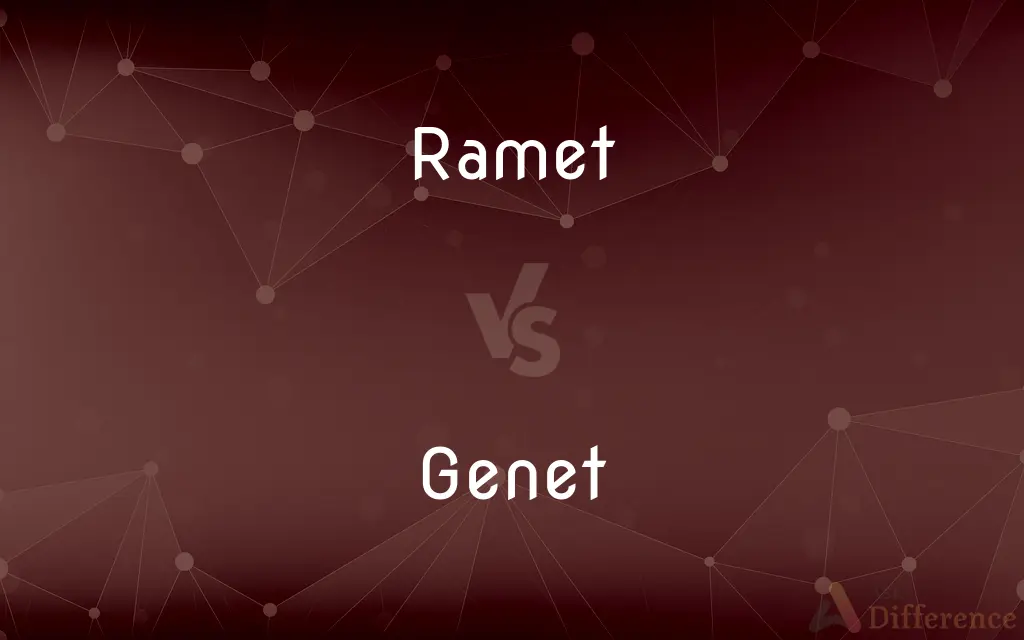Ramet vs. Genet — What's the Difference?
By Tayyaba Rehman & Fiza Rafique — Updated on April 15, 2024
Ramets are individual plants cloned from a genet, sharing identical genetics, whereas a genet is the original genetic individual in a clonal colony.

Difference Between Ramet and Genet
Table of Contents
ADVERTISEMENT
Key Differences
Ramets are individual organisms physically separated but genetically identical to the original plant, known as a genet. Whereas, a genet represents the single genetic individual from which ramets are derived, often comprising a larger, interconnected system.
Ramets can be seen as natural clones that may spread over a wide area and survive independently, even if disconnected from the original genet. On the other hand, a genet may remain centralized or spread out but is considered a single organism regardless of the physical distances between its parts.
In ecological studies, ramets are crucial for understanding how plant colonies expand, utilize resources, and adapt to environments. Whereas, genets are studied to grasp the genetic uniformity within these colonies and its effects on biodiversity and resilience.
Management and conservation practices often consider ramets in their strategies, especially in managing invasive species or restoring habitats. In contrast, understanding genets helps in preserving genetic diversity and planning for long-term ecological stability.
In agriculture and gardening, ramets can be propagated to create uniform crops or landscapes, leveraging their identical genetic makeup. Meanwhile, the study of genets is important for breeding programs aiming to enhance genetic diversity and disease resistance.
ADVERTISEMENT
Comparison Chart
Definition
A genetically identical clone of a genet, capable of independent existence.
The original genetic individual from which ramets are derived.
Physical Structure
May exist far from the original genet and function independently.
May spread but remains genetically a single organism.
Role in Ecology
Useful in studies of colonization and adaptation.
Important in understanding genetic diversity within populations.
Conservation Impact
Considered in managing invasive species and habitat restoration.
Key to preserving genetic diversity and ecological planning.
Agricultural Use
Propagated for uniform crops and landscapes.
Studied in breeding programs for genetic enhancement.
Compare with Definitions
Ramet
A plant that is an exact genetic copy of its parent plant.
Each strawberry plant in the garden is a ramet of its mother plant.
Genet
The original source from which clones are derived.
The ancient genet of this plant has spawned thousands of ramets over centuries.
Ramet
A clone produced vegetatively by a plant.
The gardener separated the ramets to increase the planting area.
Genet
A genetic individual in a population of clonal organisms.
The forest’s spread of aspen trees originates from a single genet.
Ramet
Part of a clonal colony that can exist separately.
These ramets can grow independently, even when severed from the main group.
Genet
A unit of genetic identity in ecological studies of clonal colonies.
Researchers study this genet to understand its genetic adaptation mechanisms.
Ramet
An independently surviving unit of a clonal plant colony.
After a storm, several ramets were scattered across the landscape.
Genet
Represents the genetic uniqueness in a clonal organism.
Despite the physical spread, all these plants belong to one genet.
Ramet
A member of a vegetative propagation system in plants.
Ramets enable the rapid spread of certain invasive plant species.
Genet
A basis for studying genetic diversity within clonal species.
Conserving the genet is crucial for maintaining the species’ genetic health.
Ramet
A physiologically distinct organism that is part of a group of genetically identical individuals derived from one progenitor, as a tree in a group of trees that have all sprouted from a single parent plant.
Genet
Any of several carnivorous mammals of the genus Genetta of Africa, Europe, and the Middle East, having grayish or yellowish fur with dark spots and a long ringed tail.
Ramet
(botany) A clone (individual member of a genet).
Genet
A group of genetically identical individuals descended from one progenitor, as a group of trees that have all sprouted from the roots of a single parent; a clone.
Genet
See jennet.
Genet
Any of several Old World nocturnal, carnivorous mammals, of the genus Genetta in the family Viverridae, most of which have a spotted coat and a long, ringed tail.
Genet
The fur of this mammal, or any skin dressed in imitation of it.
Genet
A small-sized, well-proportioned, Spanish horse; a jennet.
Genet
One of several species of small Carnivora of the genus Genetta, allied to the civets, but having the scent glands less developed, and without a pouch.
Genet
The fur of the common genet (Genetta vulgaris); also, any skin dressed in imitation of this fur.
Genet
A small-sized, well-proportioned, Spanish horse; a jennet.
Genet
French diplomat who in 1793 tried to draw the United States into the war between France and England (1763-1834)
Genet
French writer of novels and dramas for the theater of the absurd (1910-1986)
Genet
Agile Old World viverrine having a spotted coat and long ringed tail
Common Curiosities
How does a genet differ from a ramet?
A genet is the original genetic individual, while ramets are its clones that can function independently.
What is a ramet?
A ramet is an exact genetic replica of the original plant, known as a genet, capable of independent survival.
What role do ramets play in agriculture?
Ramets are used to propagate uniform crops and landscapes due to their identical genetics.
What is vegetative propagation in relation to ramets?
Vegetative propagation is a process where new plants grow from parts of the original plant, forming ramets.
Can the number of ramets indicate the health of a genet?
Yes, a large number of healthy ramets can indicate a robust and healthy genet.
Are all parts of a clonal colony considered genets?
No, only the original genetic source is considered the genet; all subsequent clones are ramets.
Can ramets survive without the genet?
Yes, ramets can survive and grow independently even if separated from the genet.
Why are genets important in ecology?
Genets help researchers understand genetic diversity and stability within clonal populations.
How do ramets affect biodiversity?
Since ramets are genetically identical, their spread can decrease local biodiversity.
Do genets have a physical form?
Genets may not have a distinct physical form separate from their ramets and can spread over large areas.
How does the study of ramets contribute to conservation efforts?
Studying ramets helps in managing invasive species and restoring native habitats effectively.
What implications do ramets and genets have for genetic research?
They provide valuable insights into genetic replication, mutation rates, and evolutionary biology.
What is the significance of genetic diversity in genets?
Genetic diversity in genets is crucial for the resilience and adaptability of species.
Can ramets evolve differently from the genet?
While genetically identical, environmental factors can cause ramets to exhibit different traits or adaptations.
How are ramets identified in a natural setting?
Ramets can often be identified by their physical separation and identical characteristics to the genet.
Share Your Discovery

Previous Comparison
Catalyst vs. Motivation
Next Comparison
Occasion vs. CelebrationAuthor Spotlight
Written by
Tayyaba RehmanTayyaba Rehman is a distinguished writer, currently serving as a primary contributor to askdifference.com. As a researcher in semantics and etymology, Tayyaba's passion for the complexity of languages and their distinctions has found a perfect home on the platform. Tayyaba delves into the intricacies of language, distinguishing between commonly confused words and phrases, thereby providing clarity for readers worldwide.
Co-written by
Fiza RafiqueFiza Rafique is a skilled content writer at AskDifference.com, where she meticulously refines and enhances written pieces. Drawing from her vast editorial expertise, Fiza ensures clarity, accuracy, and precision in every article. Passionate about language, she continually seeks to elevate the quality of content for readers worldwide.













































